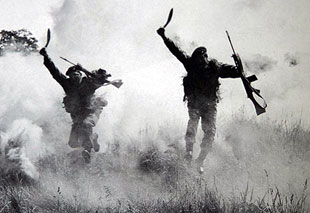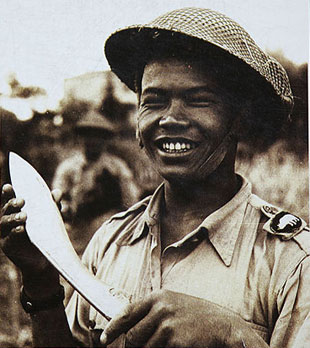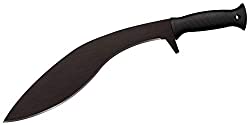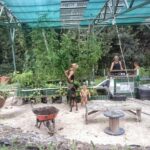Cold Steel Kukri Machete
I still can’t get over Cold Steel’s crazy demo videos. Lol……. But they did chop through a meat filled boot and that impressed the heck out of me! I happen to have owned one of these Cold Steel Kukris for about 10 years. It’s been my gardening tool, my jungle friend, my beach BBQ skewer and my camping random-tasker.
This Cold Steel Kukri machete is inexpensive($30-$40). It’s made with tough 1055 carbon steel (see link for details on 1055 steel) and it has a near indestructible Polypropylene handle. 1055 Carbon is a powerful choice for machetes, swords, axes, and shovels and it holds an edge well. I’ve chopped wood, accidentally hit rocks, thrown it, dropped it, left it outside in rain and amazingly there are no big dings in the blade. It will rust in humid environments. I’ve neglected it at times, had some rust and had to wire brush it, but if you keep it oiled and it’ll be fine.
$35 On Amazon right now with sheath.
It also makes a nice self defense weapon. It’s not uncommon to see gardeners and workers in Costa Rica walking down the road with machetes in hand. So when I take walks out with the family I usually carry it with me under the guise of using it for brush. But the reality is, no one wants to rob a guy with a machete. It’s total pain in the ***. (Hard target vs. Soft target) In addition, you never know when you might actually need to cut some brush or something needs killed/eaten. For the money, this is one of the best tools I have at the house.
Blade Length: 17″ Overall Length: 22″ Steel: 1055 Carbon Steel w/ Black Baked on Anti Rust Matte Finish Weight: 18.2 oz Blade Thickness: 2 mm Handle: 5″ Long Polypropylene
The blade is a based on the Nepalese Kukri design. The heavier end makes it bite a little more and do more damage when chopping. It’s Perfect as a lighter-weight bushcraft or camping tool that can be carried on a belt or carried in the nylon sheath it comes with. You can get it from Cold Steel in two sizes. One with 13″ blade and one with a huge 17″ blade.
Below is a little history on the design from a blade company in Nepal started by a 22 year Gurkha veteran.



From khukuriblades.com
Some of the famous knives of the world such as the Bowie Knife, the Stiletto, the Scimitar, the Roman Sword, the Machete and so on have all, at one time or the other , played great historical roles as formidable weapons with men have demonstrated raw power and courage during times of battle. The Kukri, however, outdoes them all! The great romance and the extraordinary accounts of bravery that this knife evokes are legendary.
With its origins going back to ancient times, the Kukri is not only the national knife of Nepal but is also symbolic of the Gurkha soldier, a prized possession with which he has indelibly carved an identity for himself. The awesome cutting edge of the Kukri was first experienced by the British in India who had to face it in the well-documented battles since 1814 while combating the Gorkha army in the western Nepal. Thus was born the legend and the romance. In the Gurkha soldier’s grip, this seemingly small piece of curved steel becomes an incredibly menacing weapon with which he has demonstrated rare feats of bravery while facing the enemy in many battlefields.
Kukri is a medium-length curved knife each Gurkha soldier carries with him in uniform and in battle. In his grip, it is a formidable razor sharp weapon and a cutting tool. In fact, it is an extension of his arm. When his rifle misfires, or when his bullets have run out, a Gurkha unsheathes his Kukri makes his final “do or die “run on the enemy in a fury to finish the business. This scene created the romance and the legends. What it really did, and still does, is a super-clean slaughter; the enemy tumbles down in two clean pieces and in surprise!–because his is the kindest, quickest death because it is the quickest.
Questions? Comments?




GIPHY App Key not set. Please check settings